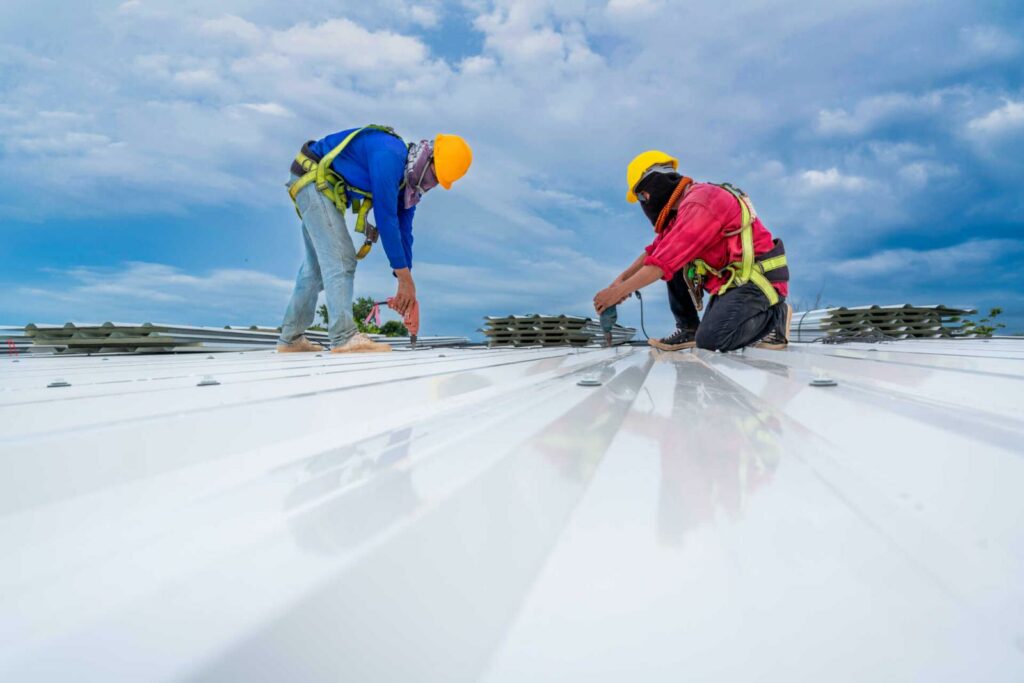Maintaining a commercial flat roof is crucial for protecting your business premises from the elements and ensuring the longevity of your building. Unlike residential roofs, which often have steep pitches and various materials, commercial flat roofs are designed to be low-sloped to maximize usable space and provide a stable platform for HVAC units and other equipment. This unique design, however, also brings its own set of challenges.
Common Issues
Commercial flat roofs are prone to several common issues that can impact their effectiveness and lifespan:
- Leaks: One of the most common problems, leaks can arise from damaged membranes, faulty seams, or penetration points. Water intrusion can lead to significant damage if not addressed promptly.
- Ponding Water: Flat roofs can experience poor drainage, leading to water pooling in certain areas. This can accelerate roof deterioration and increase the risk of leaks.
- Membrane Damage: The roofing membrane, whether it’s EPDM, TPO, or PVC, can suffer from tears, punctures, or degradation over time. Damage to the membrane compromises the roof’s protective barrier.
- Blistering: Blisters can form on the roof surface due to trapped moisture or air. These blisters can eventually burst and expose the underlying layers to damage.
Understanding the causes of these issues, such as improper installation, environmental factors, or lack of maintenance, is key to addressing them effectively.
Maintenance Tips
Regular maintenance is essential to prevent major issues and extend the life of your commercial flat roof. Here are some tips to keep your roof in top condition:
- Regular Inspections: Conduct inspections at least twice a year, preferably in spring and fall, and after severe weather events. Look for signs of damage, wear, and ponding water.
- Clean Drains and Gutters: Ensure that all drains, gutters, and downspouts are free from debris. Clogged drainage systems can lead to water accumulation and damage.
- Address Minor Repairs Promptly: Fix small issues such as tears or punctures as soon as they are identified to prevent them from becoming larger problems.
- Monitor for Ponding Water: Check for areas where water tends to pool and address any drainage issues that may be causing the problem.
Establish a maintenance schedule that aligns with these tips to keep your roof in optimal condition.
Repair Methods
When it comes to repairing a commercial flat roof, there are several methods and materials to consider:
- Patch Repairs: For minor leaks or damage, patching with appropriate materials such as roofing cement or a rubber patch can be effective. This method is relatively simple and cost-effective for small issues.
- Roof Coatings: Applying a roof coating, such as silicone or acrylic, can help extend the life of the roof by providing a protective layer over the existing membrane. This method can also improve energy efficiency by reflecting sunlight.
- Membrane Replacement: If the roofing membrane is extensively damaged, a full replacement may be necessary. This involves removing the old membrane and installing a new one, such as EPDM, TPO, or PVC.
- Professional Services: While DIY repairs can be cost-effective, professional services are often recommended for comprehensive repairs. Professionals have the expertise, tools, and materials to handle more complex issues and ensure a high-quality repair.
Weigh the pros and cons of DIY repairs versus professional services based on the severity of the damage and your budget.
Cost Considerations
The cost of repairing a commercial flat roof can vary widely depending on several factors:
- Extent of Damage: Minor repairs will generally be less expensive than major repairs or full replacements. The more extensive the damage, the higher the cost.
- Materials Used: Different roofing materials have different costs associated with them. High-quality materials may have a higher upfront cost but can offer better durability and performance.
- Labor Costs: Professional repair services will include labor costs, which can vary depending on the complexity of the repair and the rates of the service provider.
- Geographical Location: Costs can also vary based on your location, with prices often being higher in urban areas compared to rural locations.
Obtaining multiple quotes and considering the long-term value of the repair work can help you make an informed decision.
Timely repair and regular maintenance of your commercial flat roof are essential to protecting your investment and ensuring the safety and functionality of your building. By addressing issues promptly, following a maintenance schedule, and choosing the right repair methods, you can extend the life of your roof and avoid costly damage.
Investing in quality repair services and materials will ultimately save you money and ensure that your commercial flat roof continues to serve its purpose effectively.


